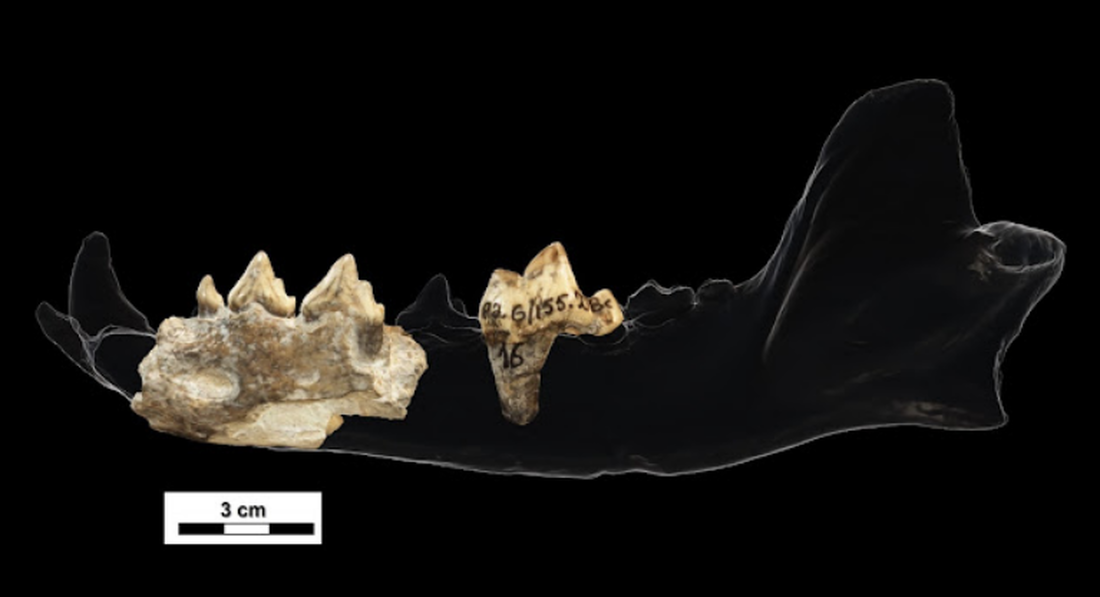A FOSSIL ANCESTOR OF THE AFRICAN PAINTED DOG IS FOUND IN DMANISI
It was a hypercarnivorous super-predator large dog that exhibits the most developed altruistic social behavior of all carnivores
The site of Dmanisi in Georgia, southern Caucasus, placed between the Black and the Caspian Seas, is dated to 1.8 million-years-old. This locality is world-wide known because it yielded the earliest evidences of human presence out of Africa. This includes the presence of five human skulls preserved almost complete together with abundant postcranial fossil specimens and a huge amount of lithic artifacts.
Dmanisi also shows one of the best records of fossil fauna for the Early Pleistocene around all the Eurasian continent. In this context, the research on the fossil carnivores developed at this site by an international Georgian-Italian-Spanish team, has described, by first time, several teeth specimens, corresponding to a large-sized hypercarnivorous fossil dog, ascribed to the species Canis (Xenocyon) lycaonoides, which is the ancestor of the African extant hunting dog, Lycaon pictus. This finding has been published in the journal Scientific Reports, of the Nature group.
This study has been leaded by the Florentine paleontologist Saverio Bartolini Lucenti, together with Lorenzo Rook, from the University of Florencia; David Lordkipanidze from the National Museum of Georgia, and the paleontologists Joan Madurell-Malapeira from the Institut Català de Paleontologia Miquel Crusafont (ICP-CERCA) and the Universidad Autónoma de Barcelona (UAB); Paul Palmqvist from the University of Málaga, and Bienvenido Martínez-Navarro ICREA Research Professor from the Institut Català de Paleoecologia Humana i Evolució Social (IPHES-CERCA) and the Universitat Rovira i Virgili of Tarragona (URV), who, together with S. Bartolini Lucenti, are the corresponding authors of the paper.
The anatomical and morphometric analyses of the fossil specimens from Dmanisi, together with data coming from all over the world, show that this species was a super-predator hypercarnivore and large-sized dog, suggesting that it was a highly social altruistic species, similar to the extant African hunting dogs. Of course, it was an important species in the ecological scenario where early Homo survived and evolved.
Contrary to other large-sized canids, such the common wolfs, it was capable of social care toward other members of its group, as it was demonstrated in a pathologic mostly complete cranium of Canis (Xenocyon) lycaonoides at the Spanish site of Venta Micena in Orce, showing that this individual managed to survive during several years thanks to the assistance of the pack. Curiously, social care was also described in the fossil humans recorded at Dmanisi based on an edentulous cranium and mandible corresponding to an old human individual, specimens D3444/D3900, which was helped to feed and survive by other members of the family group. This suggests parallel behavior in humans and this large carnivore.
The origin
The origin of the African hunting dogs is not African. These forms originated in Asia at the base of the Pleistocene, around 2.5 Myrs ago, and then dispersed into Europe and Africa at the age of Dmanisi, 2.0-1.8 Myrs. At the same time, humans, coming from Africa, dispersed into Eurasia, following the same route but in the opposite direction. Finally, these wild dogs disappeared from Europe and Asia one million years later, during the Early-Middle Pleistocene transition, but they survived in Africa until nowadays.
Hominins and hunting dogs, both recorded in Dmanisi at the beginning of their dispersal across the Old World, are the only two Early Pleistocene large mammal species with proved altruistic behavior towards their group members, an issue discussed over more than one century in evolutionary biology.
Reference:
Bartolini Lucenti, S., Madurell-Malapeira, J., Martínez-Navarro, B., Palmqvist, P., Lordkipanidze, D., Rook, L., 2021. The early hunting dog from Dmanisi with comments on the social behaviour in Canidae and hominins. Scientific Reports, DOI. 10.1038/s41598-021-92818-4


